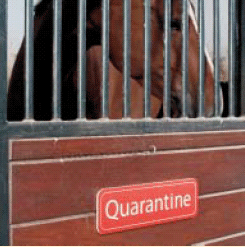
The reality of rabies
With fewer than 100 cases of rabies reported in horses, donkeys and burros every year, it’s easy to disregard the disease.But while the incidence of rabies in the United States is low, the fatality rate is high – 100 percent.
Furthermore, there is always the significant and serious potential for human exposure with any case of rabies.That’s why the American Association of Equine Practitioners (AAEP) has made rabies a core vaccine, meaning rabies vaccination is recommended for every horse, every year, regardless of geography or lifestyle.
Over the past 20 years, the number of rabies cases in both wildlife and domestic animals has increased. Typically, more than 9,000 total cases of rabies are reported in the United States every year. The rise of rabies is due, in large part, to the increased urbanization of areas where the disease is endemic in wildlife populations.
Transmission
Just because your horse doesn’t live in the woods doesn’t mean he’s out of the woods. Horses in barns, as well as horses in pastures, are likely to be exposed to rabid animals. Rabid animals can easily find their way into closed barns, climb up rafters and even enter stalls.
Horses contract rabies through the bite of an infected (rabid) animal, such as a raccoon, fox, skunk or bat. These bites typically occur on the horse’s face and muzzle or lower limbs it’s easy to mistake a rabies bite as simply a scratch, or not notice it at all.
Once bitten, the virus migrates via the horse’s peripheral nerves to the brain where it initiates rapidly progressive, invariably fatal encephalitis. The incubation period — the time between the virus’ entry into the body and the onset of clinical signs — averages two to nine weeks but may be as long as 15 months.
Clinical signs
Equine rabies can take on many different clinical signs — signs that can be nonspecific and confusing. For this reason, the disease is frequently misdiagnosed at first. Veterinarians often state that rabies “can look like anything.”
The most commonly reported clinical signs include:
- Colic
- Lameness
- Ataxia (incoordination)
- Paralysis
- Urinary incontinence
- Muscle tremors
- Fever
- Depression
- Aggressiveness
- Convulsions
- Hyperesthesia
- Abnormal vocalization (increased sensitivity)
Because of the extreme variability in clinical signs, it’s difficult to make generalizations. However, most rabid horses exhibit some degree of hyperesthesia, fever and neurological signs (ataxia and/or paralysis) at some point during the course of the disease.
While some horses exhibit intermittent or continuous signs of aggression, most infected horses are depressed or stuporous. Some may become anorexic and refuse to drink, while others will continue to eat and drink until shortly before death. Occasionally, horses exhibit signs of bruxism (grinding of the teeth). Obscure lameness and posterior ataxia (incoordination) are relatively common early signs.
In most horses, the progression of the disease is rapid with death in three to five days following the onset of clinical signs. Prior to death, most horses will become recumbent with convulsions and/or a comatose state and violent thrashing. Rabies infection in the unvaccinated horse is always fatal.
Diagnosis
There is no definitive test to diagnose rabies in a live animal. The highly variable, non-specific clinical signs — along with the lack of accurate diagnostic tests — make the diagnosis of rabies in the live horse very difficult. That’s why a rabies diagnosis is most often made only after death during post-mortem examination of the brain.
The only way to rule out rabies is to wait and see. Rabies generally progresses rapidly, so if undiagnosed neurological signs have not rapidly progressed within the first five days, rabies is most likely not the cause. Because of the serious threat for human exposure when handling a horse with rabies, any suspected case of equine rabies should be handled as if it were positive until proven otherwise.
Treatment
Currently, no treatment for horses exists. The disease is invariably fatal once clinical signs appear.
Prevention
Without a cure, rabies prevention becomes crucial. Vaccination of companion animals, including horses, against rabies cannot be overemphasized. All horses are potentially at risk and should be vaccinated.
Consider these points in regards to vaccination:
- The incidence of rabies in both wild and domestic animals is on the rise
- It’s not uncommon for pastured or stalled horses to be unknowingly exposed to wildlife
- Most exposures aren’t noticed, and most bite wounds aren’t found
- There’s significant and serious potential for human exposure from an infected animal
- Equine rabies cases are invariably fatal
- Vaccination of horses against rabies is generally safe and highly protective
